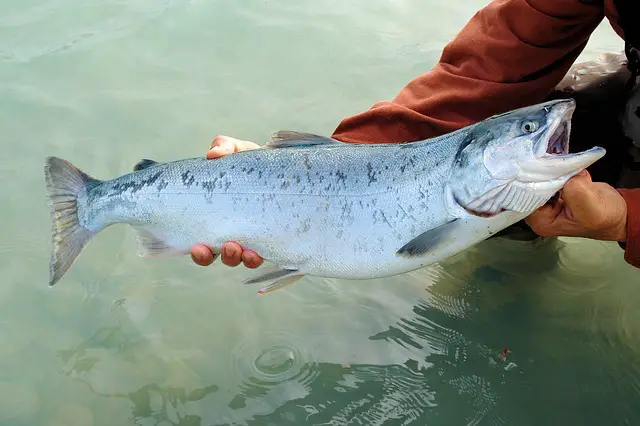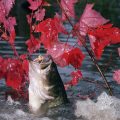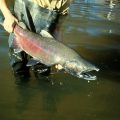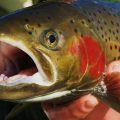Salmon is a species name for the fish that belong to Salmonidae group. The salmon fish are mainly found at the Pacific Ocean and Northern Europe. Studies about Salmon reveal they were later introduced to other areas such as South America. Notably many people in the United States are farm raising salmon. Many species breed in fresh waters and go back to the salty waters to live. The salmons therefore live in both fresh and salty waters. Notably, some species of salmon spend their entire lives in fresh waters. Salmons come in different species and are the species are spread across various continents. Some of the common species include.
Atlantic salmon
Atlantic Salmon live in fresh waters and salty waters. They have a brownish color while in salty waters and silver color while in fresh waters. They are mainly found in North Europe and America. This type of salmon has adapted to the fresh waters and does not migrate back to the ocean after laying eggs. An adult Atlantic salmon can weigh up to 24 kilograms
Coho Salmon
They are found in Columbia and Atlantic coast lines. It has a silver color and is best preferred for making sauces. They live in fresh water during breeding and salty waters as their habitat. The population of Coho has been on the decrease. The decrease is due to the destruction of their habitats especially along the streams that act as their gateways back to the ocean.
Pink Salmon
Just like its name the pink salmon is pink in color. It’s very small and weighs around 3 kilograms. it`s found in Columbia and Alaska coastal waters. Pink salmons are mainly used for sports and commercial Consumption. Notably, the pink salmon spend their entire life span in fresh waters.
Chinook salmon
Chinooks are usually white or red in color. Chinook is usually very large and an adult Chinook can weigh up to 34 kilograms. They are also regarded as the best in terms of taste. They are mainly found in California, Columbia, Alaskan and Canadian coast lines.
Sockeye Salmon

They are also referred to as “red salmons“. They are found in Pacific Ocean and their color is red. They live in salty waters and hatch in fresh waters. After spawning the sockeye salmons die. The size of female sockeyes enables them to lay many quality eggs thus increasing the chances of reproduction. Research also indicates that sockeye females prefer big males, a feature that is attributed to their ability to effectively fertilize the eggs
Salmon lifespan
Research indicates that salmons can live up to three to eight years. Many deaths occur to salmons while swimming to the salty oceans after laying their eggs in fresh waters. The deaths are usually due to low energy levels by salmon. We find that salmons do not eat while laying their eggs in the fresh waters, and this is part of their normal life cycle.
Salmon Reproduction
The first step in the cycle is migrating to fresh water. The female salmon digs the soil in the lake and lays her legs. The male salmon then fertilizes the eggs and the female salmon covers them up with soul to protect them from predators. The eggs hatch in summer and the alevins, newly spawned salmon, feed on the embryo sack. After feeding on the embryo sack, they rise above the ground and are now termed as fry.
Fry
A fry is a small salmon. The length within which a fry stays in the fresh water is dependent on the species. Most will stay in fresh waters for one month to five months to enable them to develop fully and have the strength to swim to the salty oceans.
Downstream swimming
The next step in the salmon’s life cycle is swimming back to the salty waters. Their color changes after they get into the salty waters for camouflage. Swimming is very important because it enable the fry to develop the ability to survive in the salty waters and to enable them swim for miles during procreation.
After reaching the ocean, salmon spend most of their lives in the ocean before they swim back to the fresh waters, to enable them lay their eggs and keep the cycle going.
Reproduction migration
After spending around five years in salty waters, the urge to swim to fresh waters to lay their eggs takes over and the migration begins .They dig in the ground and lay the eggs when they arrive at their spawning location .The eggs are then fertilized by the male salmon.
Salmon’s death
Salmon normally die after reproduction due to the low energy levels that are usually used up during fertilization by the male and laying of eggs by the female. Notably, salmon’s bodies are usually set to the spawning activity and thus they do not feed while in the fresh water an aspect that greatly contributes to their death. Rarely some salmon manage to find their way downstream to the salty waters. The ones that survive return to their habitat and the cycle continues until the time they die.
Distinctive characteristic of salmons
One of the most distinctive features of salmon is camouflage. They can change their color while going downstream in order to prevent themselves from being seen by predators. While in salty waters the salmons have a different color. This is because while in their habitat the salmons are usually safe thus no need to disguise themselves. Females change their color when they are about to lay eggs. The color change attracts the male salmons that fight for dominance in order to fertilize the eggs. After getting a male counterpart, the salmon then embarks on its journey to search for a breeding place mile away from the salty waters.
Salmon Diet
Salmon diet depends on the development stage. After hatching, the alevins feed on the yolk sack. The fry normally feed on insects, flies and terrestrial plants to enable them












Pingback: Best salmon lures | Reel Fishing Guru
Pingback: Best salmon fishing reels | Reel Fishing Guru
Pingback: Best Salmon Fishing rods | Reel Fishing Guru
Pingback: Is Grouper Bad for Gout? | Reel Fishing Guru